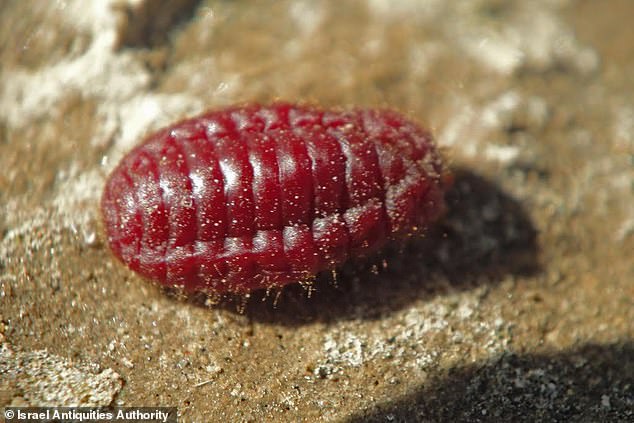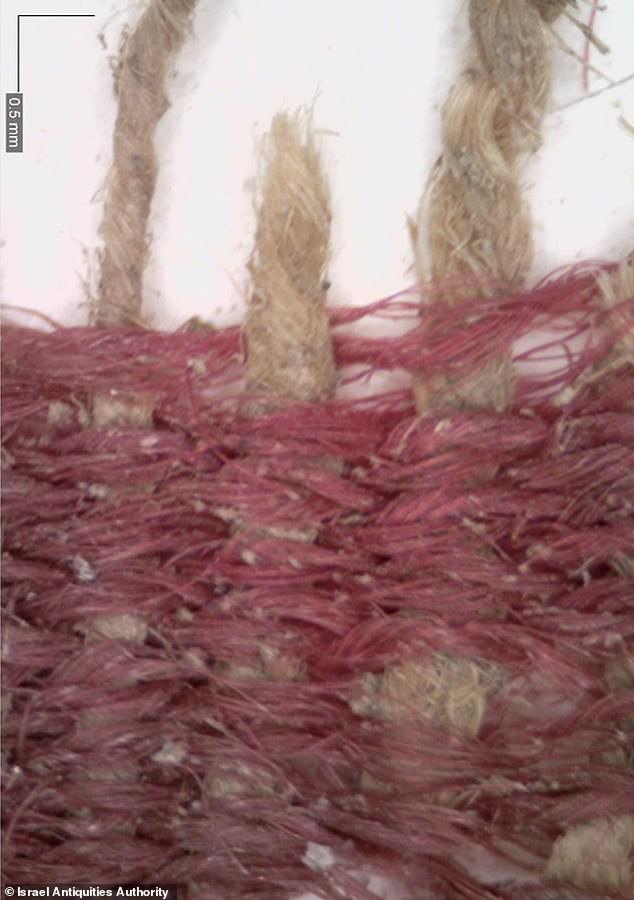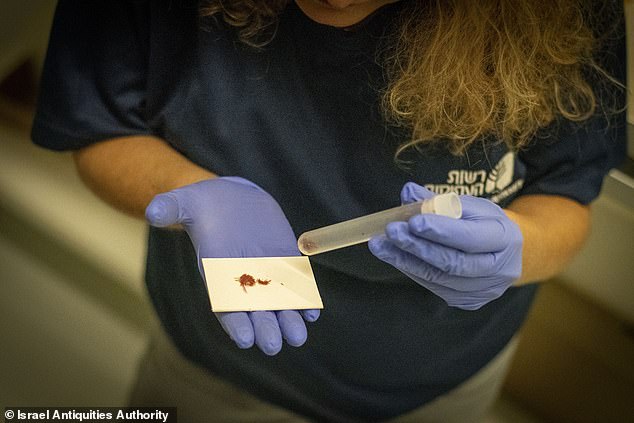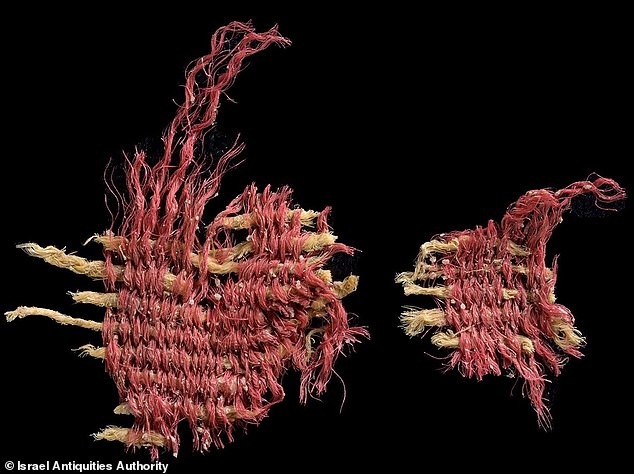Archaeologists have discovered a rare artifact found throughout the Old Testament of the Bible.
A 3,800-year-old textile dyed with “scarlet worm,” a dye mentioned 25 times in Scripture, was discovered in a cave in Israel.
Red dye was created from the corpses and eggs of an insect, which people ground into a powder to color clothing.
The fabric was composed of red-dyed wool threads, which had been woven through undyed linen threads to form a lattice-like design.
The Israel Antiquities Authority (IAA) announced the findings on Thursday, after finding the textile measuring less than two centimeters hidden in the “Cave of Skulls” in the Judean Desert.
The fabric featured red-dyed wool threads, which had been woven through undyed linen threads to form a lattice-like design.
The ‘scarlet worm’ mentioned in the Bible is a scale insect that lives in oak trees, the principal species in the ancient world being the Kermes.
Females and their eggs produce carminic acid, which gives the dye its red color.
People collected the insects, doused them with vinegar, dried the corpses, and then ground the remains into a powder that they used to dye fabrics and clothing.
‘The red hue, which ranges from orange to pink to crimson, has held significant symbolism and historical significance,’ the team shared in the study published in the peer-reviewed Journal of Archaeological Science.
‘The red colour of cochineals, which is based on molecules such as kermesic acid or carminic acid, is stable and beautiful, making them much more prestigious than plant-based sources of dyes.’
The scarlet dye is known as shani or tola’at shani in Hebrew (meaning crimson worm) and appears throughout the Old Testament alone or together with other precious dyes, including the blue and purple dyes of sea snails.
Leviticus 14:16 says, ‘As for the living bird, he shall take the cedar wood, the scarlet, and the hyssop, and dip them, together with the living bird, in the blood of the dead bird over the running water.’

The Israel Antiquities Authority (IAA) announced the findings on Thursday, after finding the less than two-centimeter-long fabric hidden in the ‘Cave of Skulls’ in the Judean Desert.

The scarlet worm mentioned in the Bible is a cochineal that lives in oak trees, the principal species in the ancient world being the Kermes. The females and their eggs produce carminic acid, which gives the dye its red color.
The deep red color is also mentioned in Exodus a couple of times, specifically in chapter 26, verse 1: ‘Make the tabernacle with ten curtains of finely twisted linen and blue, purple, and scarlet yarn, with cherubim woven into them by a skilled craftsman.’
The use of Kermes is also mentioned in the Stockholm Papyrus, which contains 154 recipes for dyeing, colouring precious stones, cleaning pearls and imitating gold and silver.
The manuscript dates from Between 200 and 100 BC
The red dye of Kermes is also mentioned in ancient trade documents, such as in cuneiform tablets from Mesopotamia, dating back to 1425 BC.
The team discovered the ancient textile in Israel, finding a plant-based material from the southern Levant that was used to make the fibers, and the weft threads were made of wool.
‘It is a striped fabric with a weft in the weft system and 10 threads per cm in the warp,’ the study reads.
The weft threads are arranged compactly, while the warp threads are more widely spaced.

The team discovered the ancient fabric in Israel, finding a plant-based material from the southern Levant that was used to make the fibers and the weft threads were made of wool.

The team found several ancient textiles in the cave, but only one was dyed with the biblical color.
The weft threads were a bridal red color, which was woven between undyed warp threads.
The researchers determined the dyes using the high-performance liquid chromatography (HPLC) analysis method, which separates the compounds dissolved in a liquid sample to identify the components of the mixture.
They then compared the findings to a database containing standards with known chemical components, revealing kermesic acid, which is secreted by the insects.
The fabric was dated to the Middle Bronze Age (1767-1954 BC) by carbon-14 analysis.
Dr Naama Sukenik of the IAA said: ‘This advanced analytical method allowed us to trace the origin of the dye back to the exact species of scale insect.
‘Therefore, we can determine with high probability that in ancient times, the fabric was dyed using a kind of Kermes vermilion, which produces kermesic acid, which imparts the distinctive red hue.’

The researchers determined the dyes using the high-performance liquid chromatography (HPLC) analysis method, which separates the compounds dissolved in a liquid sample to identify the components of the mixture.
Professor Zohar Amar of Bar-Ilan University said: ‘The term ‘worm’ in ancient times was a general term for various insects and their developmental stages.
The biblical association of this color with a living being demonstrates impressive zoological knowledge, considering that female cochineals lack legs and wings, to the point that some Greek and Roman naturalists even confused them with plant granules.
‘Throughout history, various species of cochineal have been used to produce red dye.
‘To this day, in South America, another species of cochineal, which lives on certain species of cactus, is used to dye textiles.
Despite the large amount of written historical evidence of the widespread use of cochineal dyeing in the ancient world, very few cochineal-dyed textiles from before the Roman period have been found anywhere in the world to date.
“This important find bridges the gap between written sources and archaeological discoveries, providing evidence that the ancient textile dyeing industry was, at this stage, already sufficiently established for dyeing using animals,” said Dr Sukenik.
‘This rare textile is a testament to the extensive international trade networks that were already in operation at that time and indicates the presence of an elite society.’

